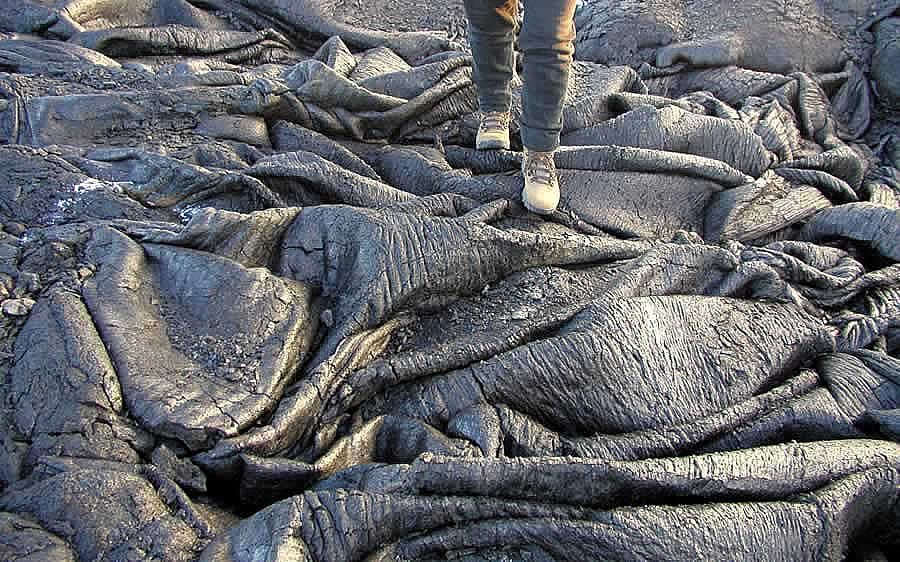
Walking on pahoehoe lava

You don't think in terms of actually walking on lava. But that's what you end up doing because ALL the land in Hawai'i is lava. So you're doing it as soon as you get off the airplane. The trick is to find some that is hot enough to melt your sneakers!
Kit has been fascinated with volcanoes since she was a schoolgirl. In 1960, National Geographic magazine featured a glorious pictorial about the Big Island's new eruption Kilauea Iki (“Little Kilauea”), and it seized her imagination. She dreamed of witnessing moving lava some day. Years would pass before she got her opportunity.
We tried before. In 1991 we walked on cooled Hawaiian lava that had subsumed cars, buildings and roads in the mid-1980s. But we saw no active flow. When Madame Pele resumed her eruption two years later, Kit cursed her timing.
But 2007 turned out to be our lucky year. Let us take you there...
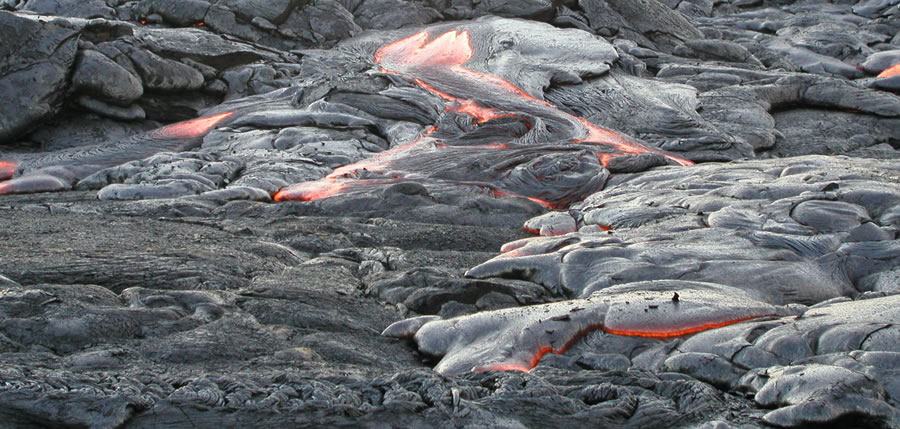
A flow of fresh, viscous lava, with a cooling skin
The first day of June we climb on a plane after dusk and fly westward into the darkness. A mere five hours later we step into warm, moist paradise. We can never get used to this. Steve tells the rental car clerk that he finds it impossible to arrive in Hawai'i without a smile on his face.
We spend our first night in Hilo then hit the Farmers Market the next day before setting off for the town of Volcano. At the market Steve meets a guy selling videos of his trek to Pu'u O'o, Kilauea’s active vent: John Osprey describes how he hiked four hours through thick jungle and up to the vent, twice in two days the previous year. We had heard this trek described similarly by others and now doubt we can handle it, so we buy the CD that Osprey is offering for $10. It's a six-minute slide show of 41 dramatic photos he took, set to music he composed and performed himself, and it's entrancing. Here's where to order your own copy.
We arrive at My Island Bed & Breakfast Inn in the town of Volcano later that afternoon and are immediately briefed by proprietor Gordon Morse about what we can do, and where. (We were to learn later that he had met and hosted the internationally renowned vulcanologists Maurice and Katia Krafft during their many visits to Hawai'i.)
Gordon's best advice is to pay attention at the breakfast table and listen to the volcanic adventures of others. It's a good idea: we consider driving to the end of Chain of Craters road in Hawai'i Volcanoes National Park and walking in across the lava from the west, but drop that idea after one discouraged couple tells us they had hiked for 7 hours—3.5 in and 3.5 back—seeing nothing of value. Yow.
Friends in Petaluma had visited Pele’s heart a month before, and their son had squired them on a much shorter hike to real flowing lava. They returned with spectacular photos as well as specific advice on what to wear, when and where to go: from the east, not the west. Outside the Park. Under cover of darkness.
But our maps are vague and we don’t know exactly where to begin. Again, we wonder about our stamina.
JUNE 3
We decide to try a "test" hike first to stretch our legs and break in our heavy new boots. Gordon recommends a beautiful course: across Kilauea Iki crater, the very same crater whose fountains of lava had so enthralled Kit 47 years earlier. Now the sunken crater is cold and hard.
|
The hike actually begins in a rain forest lush with ferns and ‘ohi’a trees. We circumscribe the north half of the crater rim and then descend to the crater floor where a faint hiking trail has been beaten into the glassy stone, and turn back eastward. A 'a (AH-ah) lava rubble makes the first quarter of the crater floor a difficult trek. It looks frothy and pointed like whipped cream but is sharp and uneven and hard work. Many thanks to our friends who warned us to bring heavy hiking boots! Only the rock cairns of previous explorers indicate where to walk.
|
Then—joy!—we’re on a bed of pahoehoe (pah-HOY-hoy) lava, once laid down like soft pudding and now resembling bunched-up cloth. It still requires a sharp eye to navigate but is much kinder, and sounds like crushed glass under our boots. As the sun dips over the crater rim, the air cools and steam vents become visible around us on the floor. Marveling, we climb back up through the fern forest.
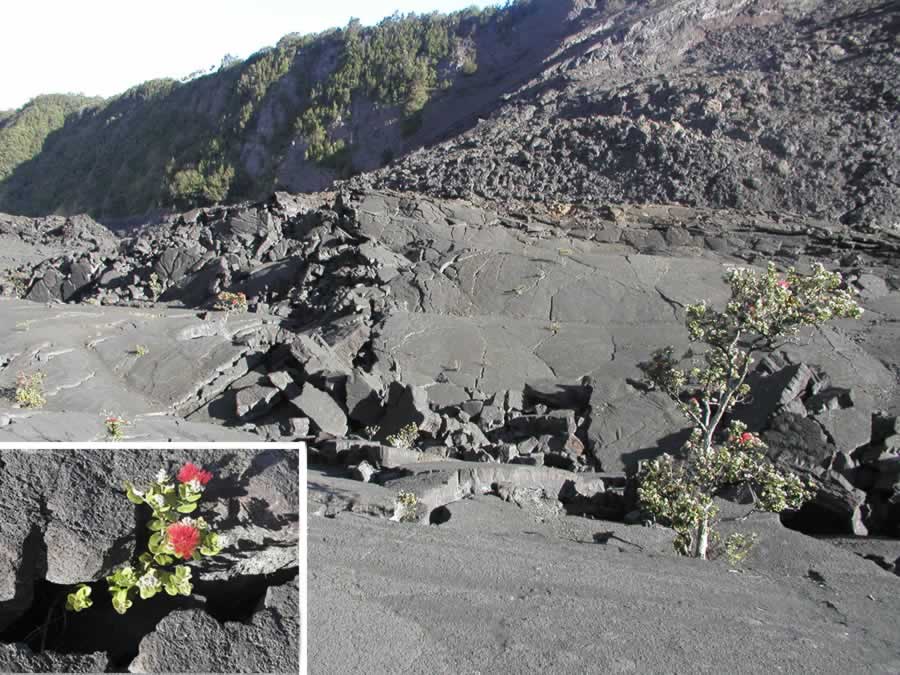
Lava never remains lifeless for long
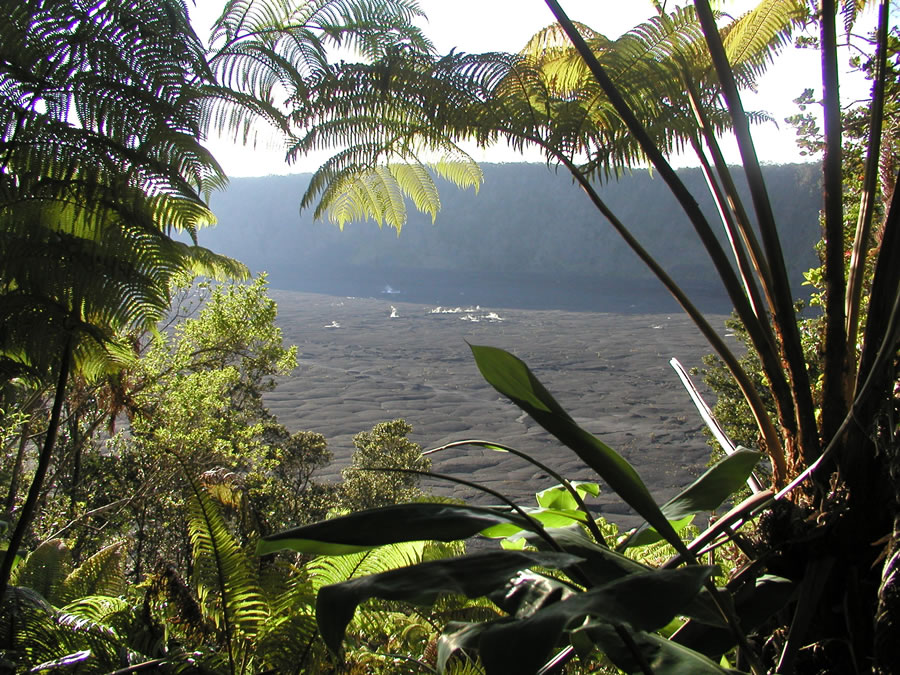
Steam vents on the crater floor
With this success under our belts, we find ourselves more energized than exhausted. We declare ourselves ready for the East Rift Zone of Kilauea.
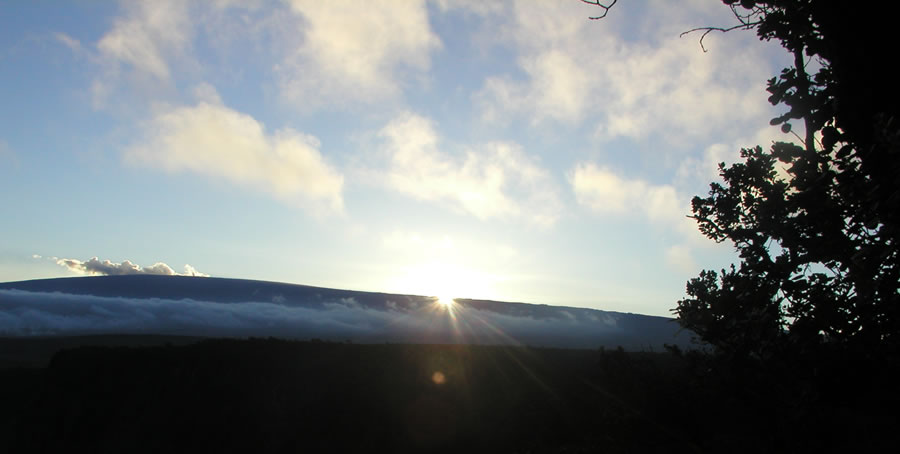
Sunset behind Mauna Loa
JUNE 4
The next day we turn south off the highway between Hilo and Volcano, and drive south into the Puna region—old sugar cane plantations turned to organic farming. In some ways it's a suburb of Hilo, but we had heard a lot about how lawless it was. Hippies and bandits and disgruntled natives, if you cared to believe the stories; park your car and go looking for lava, and it might be stripped or just plain gone when you get back.
We do see a few scruffy hitchhikers: Rasta locks and deep tans. When the road ends at a lava flow, we get out to read the sign that begins: "Residents only." (Residents, here? You’ve got to be kidding.) But over the next few minutes, several cars obviously carrying tourists zip on by. So we follow.
Over the next two miles, we bump across old lava, then back onto a small section of highway, and over more lava; this cycle repeats four times. Finally, no more road at all but a small pahoehoe parking lot with a half dozen other cars. Facing due west a few miles over the blackened lava waste we notice steam rising from the Pu'u'O'o vent upslope: this is where the lava originates. Downslope toward the ocean, clouds of steam rise where lava hits the water. The vista is vast and we feel insignificant.
|
We walk out about a quarter mile to the first rise, and are a little surprised to find another rise out there another quarter mile or so. We don't appear to be one inch closer to the action. It’s early afternoon and the sun reflecting over the black lava is brutal. We decide to undertake our grand adventure tomorrow. Now we know the lay of the land.
Back in the car, we are satisfied at least that we can make the hike with boots, our strap-to-the-head flashlights, our compass, and our burning desire.
|
|
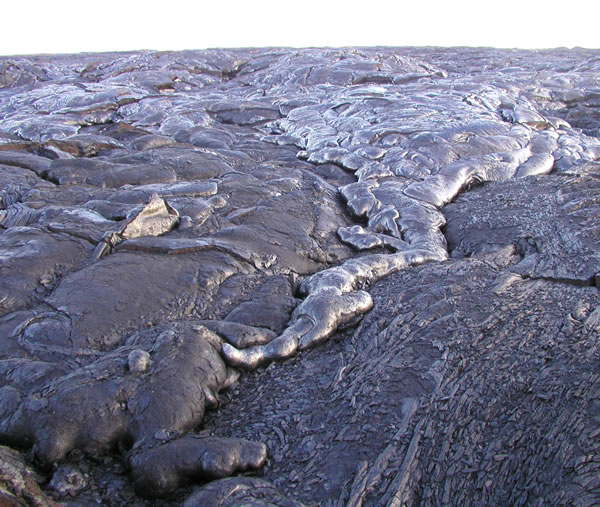 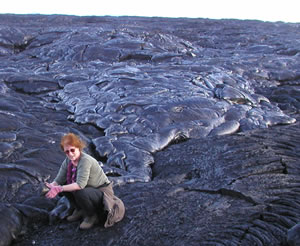 Kit sits on a "toe" of fresh lava |
Side story: Next to volcanoes, Kit’s pet passion is tropical “tiki” drinks. We were forewarned that Hawaii has no tiki bars—there’s no need! The guidebook directs us to a funky Mexican restaurant and bar, Luquin’s, located in Pahoa, the largest settlement in Puna. Mango margaritas! Lilikoi (passion fruit) martinis! And something called li hing mui, an Asian plum flavor designed by nature to be a mixer. Heaven in a garnished glass! Our hearts and minds are happy tonight.
Next day, Luquin’s is our first stop on the way to the lava. Liquid courage...
|
Luquin's doesn't look like much, inside or outside, and a Mexican restaurant in Hawaii seems as much a non sequitur as a tiki bar. But logic is wrong: Hawaii does need a tiki bar. Luquin's food is passable, but the drinks are outstanding, so this place will do! Over the course of our 2 weeks on the Big Island, we go there 5 or 6 times... |
JUNE 5
We reach the "parking lot," prepare ourselves and start out shortly after 5 p.m. We head WSW, toward a point halfway between two columns of steam: one rising from the ocean’s edge and one rising from the rift atop the summit. After each ridge there's another ridge in the distance and pretty soon we're just “out there,” walking on the blackened surface that might as well be the Moon. The sun meets the horizon in front of us.
We begin to tire of the monotonous landscape and wonder if our course makes sense. Then, a cry, “Look! There it is!” choked with excitement. Straight ahead, a small incandescent orange glow appears about 20 feet away, framed in black rock. We notice a second one, on the same level. It seems impossible—a pair of “eyes” peering at us, watching our movements . . . the eyes of Madame Pele, whose domain we trespass! Kit looks at her watch: 6 p.m. The realization hits us that we’re in a “live” zone and the hair stands up on the back of our necks.
We approach and see that the “eyes” of molten lava indeed appear alive. We notice too that the lava we're walking on is now silvery. (Up until now it's been an iridescent black.) This silvery surface is newer, only recently cooled. We take each step with care.
|
As darkness falls, we begin to see more spots of color, and the slow hike becomes an breathless dash from tidbit to tidbit of glowing ooze. The sun is now down, but we feel hotter, and it's not just our excitement—we look down into surface cracks beneath our feet and see a red lava 12 to 18 inches below. We are actually walking on a stream of lava with a solid crust!
We now notice live steam vents in front of us, reeking of sulfur. We decide that maybe we've gone far enough forward even though there are more and brighter views of lava. We’ll go uphill, parallel to the flow.
Steve is still envisioning a swift, flowing river like in the films for sale at the NPS visitor center. It's clear that we won't get to see lava drop into the ocean; we can't safely get anywhere near the shore because of the darkness and clouds of hot steam. And it's slowly dawning on us that a river of lava is not in the cards, either.
From a safety standpoint, that's probably just as well. We’re no match for that much natural force, especially at night.
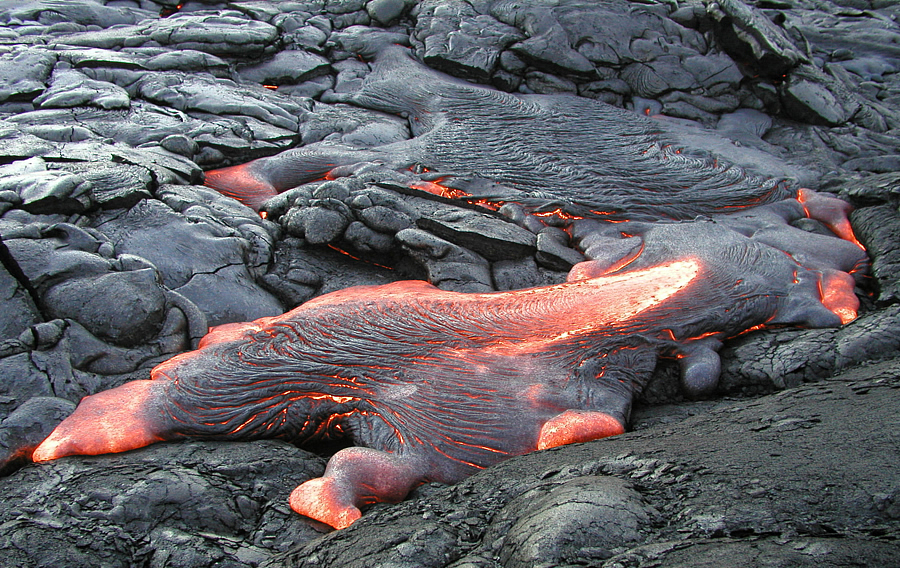
Watch your step... this stuff just oozes out of the ground.
Looking back toward the parking lot, we see more and more of the red glows. We’ve been walking among them for the last half hour but they didn't show up in daylight. We’re treading upon barely solid earth.
We come upon some dazzling little flows: springs of moving lava a few feet wide and much longer. At first glance they look almost stationary, but even though highly viscous, they do indeed flow downhill at a snail’s pace, maybe one foot a minute. This is the real thing! This is how new land is built, inch by inch.
The leading edges of the flow—tentacles called “lava toes”—follow each little crevice and hollow of solid lava laid down earlier. Steve tosses a rock onto the surface of one flow and is surprised that instead of sinking into the ooze, it bounces off! The surface is trying to cool, but can’t quite do it yet because movement propels the underlying mass forward. Every time a new glass skin forms it shatters almost immediately, and the air rings with the delicate, unending tinkle of breaking glass.
How Steve Fried His Camera The lava in this movie occupied an area of about 36 inches by 18 inches. You're not impressed? It was blast-furnace hot! Steve got as close as he could: about 8 feet. He held the camera closer—the length of his arm—and shot the movie. <<== Click on it there; if you have the right software, you can watch and listen. Below the whoosh of the wind, you can hear the snap-crackle-pop of the lava's surface cooling, hardening, heating, shattering continually. Also Kit and Steve oohing and aahing. Steve forgot that he was asking plastic gears to withstand intense heat. After that, the camera couldn't retract its lens any more when switched off; instead it whined and clicked. A few days later, it died entirely. |
The intense heat keeps us at a distance of at least eight feet away; getting any closer is simply not possible. We cannot tell if these flows issue from a nearby fissure or are the leading edge of lava extruded a quarter mile uphill.
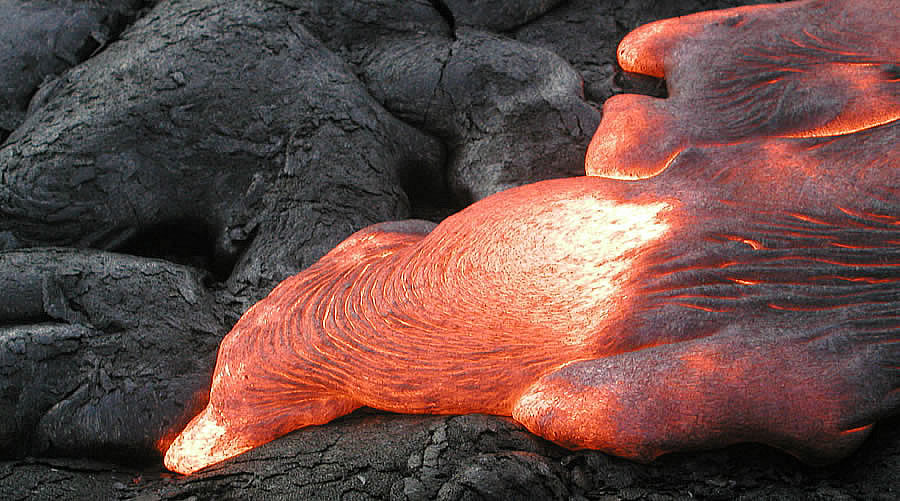
A close-up of the ooze: a "dead bird" shape
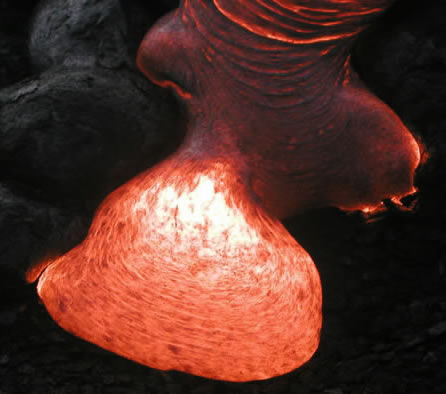 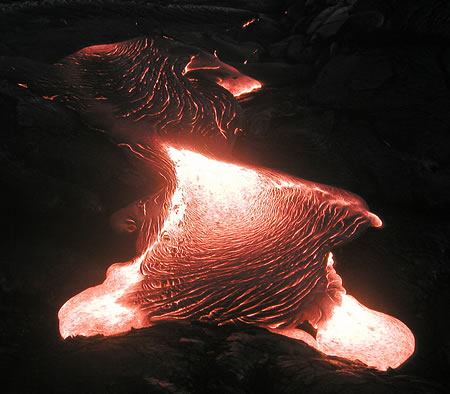 Liquid lava is between 1200 and 2000 degrees farenheit, but the surface is hard like glass. |
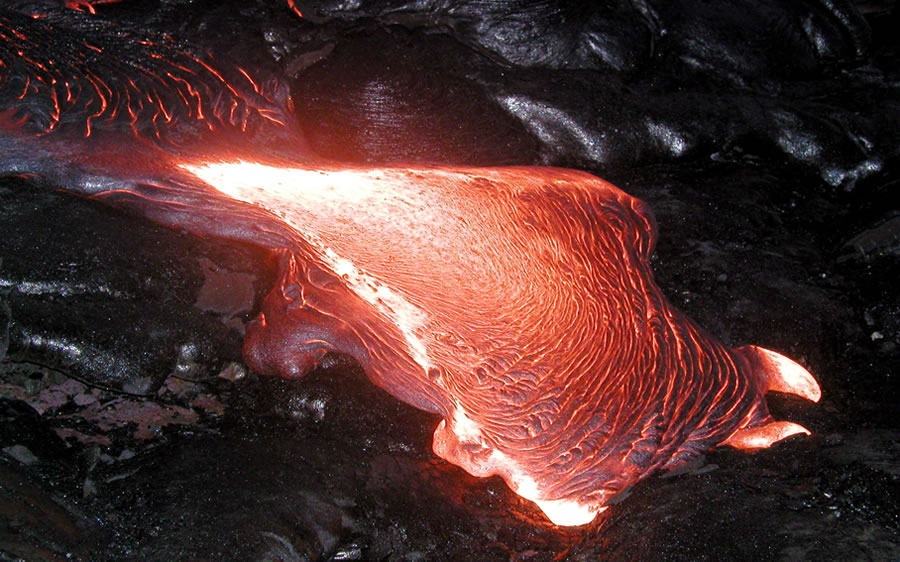
You can't get closer than about 8 feet ...it's like standing next to a blast furnace!
|
We spend at least 90 minutes in the gathering dark surveying the hot scene from a perch on a cold black lava outcropping, taking photos and movies, drinking water and eating a backpack dinner. What a show! Kit comments that the only thing that could make this better would be huge lizards lumbering over the uneven surface. (To see that, check out the climax of 1959's Journey to the Center of the Earth starring James Mason.)
We turn back in total darkness—now using headlamps and flashlights—for a long and painstaking return. Away from the steamy “action” we behold a sky pierced with brilliant stars. We view the splendid Southern Cross for the first time, and several other constellations we've only seen in star charts. Finally we see a red signal lamp (erected by whom? to guide us unlawful trespassers) and we know the end is in sight.
Back at the "parking lot" where over a dozen vehicles are now parked, amplified music tells us we’re no longer isolated. The atmosphere is festive as people swap tales of their adventures. What a great night, and it's only 9 o'clock!
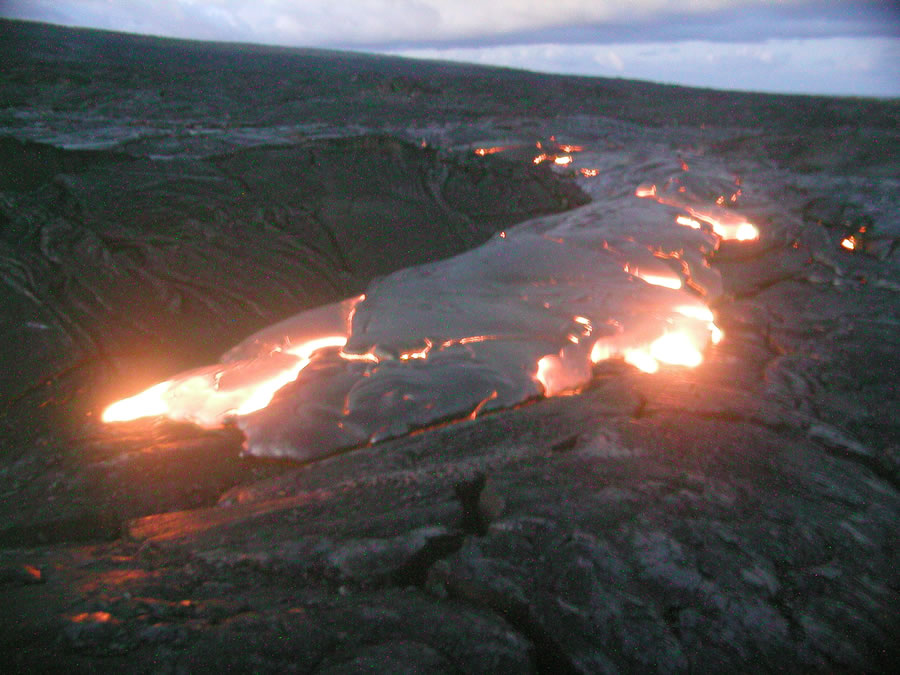
The juxtaposition of bright hot lava, dark cold rock, and the horizon at dusk makes a long shot difficult to focus.
Look at the reflection of glowing lava at the lower left.
This is our planet at its most elemental!
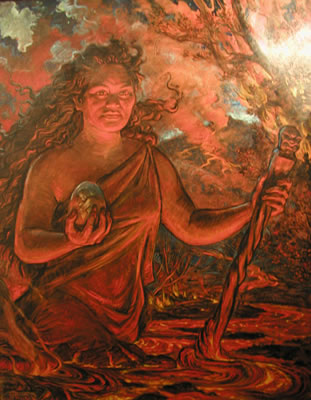 Madam Pele, Hawaiian goddess of fire Above: She holds the egg of creation |
LINKS Astounding Photography! National Park Service pages Giant map of the lava flow area |